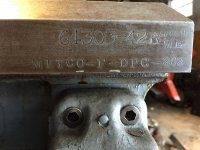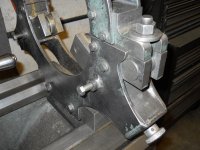inwoodcutter
Cast Iron
- Joined
- Mar 10, 2005
- Location
- Tell City, Indiana
My brother and I recently won at auction a "Raised" 14" x 126" American Pacemaker. We already had a 16 x 54 and like operating Pacemakers. At first we thought the online auction listing was wrong and this was actually a 22" machine. It swings 24 1/2" over the ways but all the components are built "light" (and I use the term loosely as nothing on a Pacemaker is light) as on a 14" machine rather than the overbuilt style on a true 22" machine. What it means is a lathe that is about 5,000 lbs lighter than one built for that size swing. I'm figuring this weighs just shy of 7,000 lbs. It's great for us as we'll only really need it for occasional light use. This one was built in '55 and has very little wear. It's an extremely tight machine.
My first question is what are the limits of a raised machine vs. one built for that size? Is there a noticeable cut difference when having the cross slide all the way out to make a cut? Will I need to have some additional compensation for large work in this to account for it flexing more?
Second and see the pictures below, I want to make a steady for both this and the 16" machine that have a range up to the size that just rides over the cross slide. What should I design into the steady for something that size? I drew up something in CAD and printed it full scale, glued to plywood and cut out just to see how it looks, verify clearences. The design is very similar to the original in features and we'll likely have them burned out of thick plate.
Thanks,
Dan
My first question is what are the limits of a raised machine vs. one built for that size? Is there a noticeable cut difference when having the cross slide all the way out to make a cut? Will I need to have some additional compensation for large work in this to account for it flexing more?
Second and see the pictures below, I want to make a steady for both this and the 16" machine that have a range up to the size that just rides over the cross slide. What should I design into the steady for something that size? I drew up something in CAD and printed it full scale, glued to plywood and cut out just to see how it looks, verify clearences. The design is very similar to the original in features and we'll likely have them burned out of thick plate.
Thanks,
Dan








